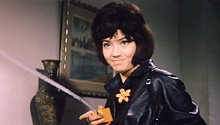
|
Review: Black Tight KillersBy Chris HydeDecember 3, 2002
The appeal of the spy film seems timeless and near universal, with film industries the world over continually donning the cloak of espionage throughout film history. Influenced by the success of the James Bond franchise, during the Sixties a swinging brand of pop spy film emerged that was typified domestically with the Our Man Flint and Matt Helm series. Internationally, this trend crystallized in European films like Mario Bava’s Danger: Diabolik; in Asia it helped color the work of the great Seijun Suzuki and led directly to the film we’ll remember today, Yasuharu Hasebe’s Black Tight Killers. Also known under the provocative title Don’t Touch Me I’m Dangerous, the film stars Akira Kobayashi as a war photographer who gets mixed up in the spy business when his stylish stewardess girlfriend (played by Chieko Matsubara) is kidnapped. Both of these principals are representative of the Nikkatsu studio and the era in which the film was made, and in fact they had earlier worked together on three previous Suzuki projects for the company. Kobayashi is also known for his lead work for Nikkatsu in their popular “Wataridori” (Wandering Guitarist) and “Nagaremono” (Drifter) series, his somewhat reticent style being ideal for the mysterious, tough guy characters these films require. Chieko Matsubara, for her part, has contributed much to Japanese cinema with her career. In addition to her stewardess role in Black Tight Killers she is the primary actress in the brilliant Tokyo Drifter, a wild 1966 yakuza outing that must be seen to be believed. After 1970 she left acting for a decade, but returned for some television work over the next twenty years and more recently has resurfaced in the latest Takeshi Kitano film, Dolls. Contemporary ventures aside, it’s the sultry actress in the spy story from over thirty years ago that concerns us here today. As the flimsy structure of the plot of Black Tight Killers advances, the wending trail of intrigue followed by Kobayashi seeking his lost frail leads to doubletalk tales of stashed wartime gold. Also spicing up the action is the arrival of the trained assassins of the title, a trio of young Japanese women in catsuits with deadly weaponry consisting of 45 records and chewing gum. Needless to say, the story structure employed here hardly approaches the level of the great Eastern classics. But the form that envelops the fable is so eye-catching that the absurd machinations of the plot are merely a sideline. The entire film is drenched in a 1960s go-go sensibility that jumps frenetically from the screen in intense bursts of neon color, with vibrant hues expressionistically washing frames of action and romance. Nightclub dance scenes that seem an Oriental version of the beginning of Faster Pussycat! Kill! Kill! combine with eerie psychedelic nighttime drives as the director piles stylizations one on top of another while the action ratchets up. There’s little to do but sit back and enjoy the ride; the intense mod feel of the visuals carries the hilariously ridiculous plot and makes entertaining the clichéd spy genre trappings. The pop candy stripe colors employed in the look of Black Tight Killers evoke a very specific period in the history of the motion picture and, in fact, of fashion itself. Early 1960s modernism was a breezy and smooth international style accompanied by an emphatic use of color, and in this way the current film shares something with Jacques Demy’s seminal work The Umbrellas of Cherbourg. Completely unrealistic in tone, the colors utilized in both films articulate a look that reflects an emerging space age feel that would become commonplace later in the decade. In Black Tight Killers, energetic blues, reds, greens and yellows briskly paint the scenes and act as chromatic underpinning to breathless sequences of action. Perfectly countenancing the film’s suave spy storyline, this saturated visual sense lends a sophisticated, jetset air to this arresting tale of female ninja assassins in fashionable hairdos. Accompanied by a bouncy musical score, the action of Black Tight Killers plays out with loosely coordinated abandon. The simple movie pleasures contained within are completely entertaining in their own right, and the fantastically colored wrapping in which the skimpy plot is enveloped lends a stylish effect to the proceedings. The result is simply lively and fun filmmaking that utterly defines a certain mod international ethos that appeared during the 1960s. In any case, it’s certainly a different beast than the formulaic spy fare that rakes in the cash at the megaplex now-we should be so lucky as to have a triple threat of catsuited Japanese vixens winging deadly bubblegum show up these days to spice up the action.
|
Friday, November 01, 2024
© 2006 Box Office Prophets, a division of One Of Us, Inc.